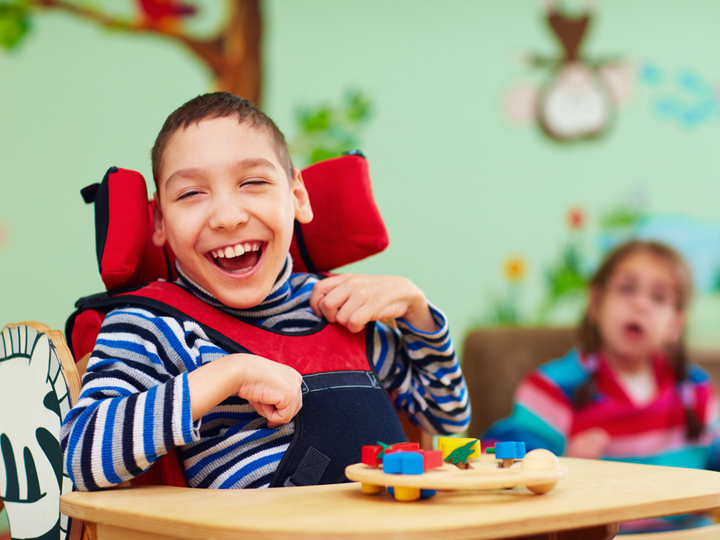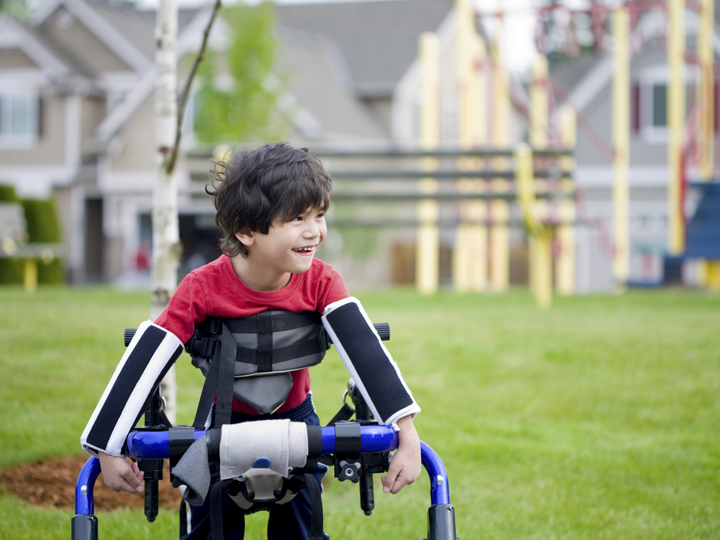Cerebral palsy

Cerebral palsy is an umbrella term for a range of conditions which cause a child to have difficulty with movement and muscle control. It is caused by an early injury to the developing brain either before, during, or immediately after birth.
What is cerebral palsy?
Cerebral Palsy is classified according to the parts of the body most affected.
- 4 limb cerebral palsy, previously known as quadriplegia which affects the whole body
- hemiplegia which affects one side of the body
- diplegia which affects just the legs
Cerebral palsy may also be described in terms of the nature of the movement difficulties encountered. For example, most commonly, spastic or spasticity meaning high muscle tone (tight muscles), dystonic, where muscles are held in stiff, awkward positions or dyskinetic representing a mixture of spastic and dystonic types. As your child continues to develop, their muscles and movement patterns may change over time. Each child is different and the difficulties may range from mild to severe.
Children with cerebral palsy often have difficulties in other areas of health and development, for example, epilepsy, feeding, speech, vision and learning.
Your child's cerebral palsy is also classified according to their functional level. For example, how well they move around and participate in all aspects of home, school and community life.
Classification systems
We may use some or all of the below classifications systems to describe your child's daily functioning.
What you can do to help
There are lots of things you can do to help. A physiotherapist will advise about exercise, positioning and stretches. Both an occupational therapist and a physiotherapist will help with any equipment that might be needed. They will talk through how your child can participate in the activities they need and want to do at home, at school and at play.
You can support your child with exercise and stretching, by making it fun and part of their daily life. Give your child lots of opportunities for exercise and play, just like any other child. “Use it or lose it” is particularly important in children with cerebral palsy. There is evidence to show that exercises improving muscle strength improve overall function. We also know that for everyone, muscles tend to get weaker as you enter your twenties, so being as strong as possible will help improve your function.
Speech and language therapists will advise about communication and feeding. We know that exercise and strengthening is very helpful for all children with cerebral palsy, so we recommend that you keep your child as active as possible, making sure that they are not overweight. Encourage them to do as many things as possible such as joining a sports club, just like any other child.
How we can help
Initially, you and your child will be seen by a paediatrician who will confirm the diagnosis and think about any medical tests that are needed. Some children may require blood tests or a brain scan.
All children will have a lead paediatrician who has responsibility for their overall care. Appointments will be arranged by the clinic co-ordinator.
After the age of 2 years, children are seen every year in joint clinics with a multidisciplinary team (MDT) including paediatricians and therapists working together to:
- discuss your concerns
- examine your child using the CPIP assessment tool
- monitor their progress
- advise about what additional support, exercises or equipment may be needed both at home and at school
Paediatricians will also assess for and treat other conditions such as epilepsy, feeding difficulties and bowel problems. Paediatric care continues up to the age of 16 years, or 19 years for those attending a special school.
After each MDT clinic review a report is prepared which is shared with your GP, your child’s school and any other relevant health professionals, with your consent.
Hip and spine monitoring through the Cerebral Palsy Integrated Pathway (CPIP)
Children with cerebral palsy have increased muscle tone, often around the hips. Over time this can mean that the ball shaped head of the femur (long bone) may be slowly pulled out of the hip socket, a process called subluxation or dislocation. This can be painful and eventually may need surgery.
We follow the CPIP pathway which monitors the joint range of movement and posture. This is combined with X-rays to try to reduce this risk. The physiotherapists will take regular measurements of a child’s joint ranges and rate them on a traffic light system.
- Green means no concern.
- Yellow means mild concerns which may need adjustment to physiotherapy programme.
- Red means there is a concern requiring intervention.
The physiotherapist will advise on targeted exercises, stretches and specialist equipment if needed. They may ask for tests and X-rays or a clinic appointment with the doctors. A targeted exercise programme, physical activities and postural management are the mainstay of treatment in preventing muscles becoming too tight for children with cerebral palsy, and should be completed on a daily basis.
Children with cerebral palsy are also monitored for scoliosis, or curvature of the spine. This may arise due to uneven muscle tone in the spinal muscles which causes the spine to develop an S-shaped curve when viewed from behind. In the majority of cases this is not painful, but it requires monitoring as it may progress. Children with scoliosis may be required to wear a lycra support or a brace, and corrective surgery may be required for severe scoliosis.
Treatment for children with cerebral palsy
Children with cerebral palsy have muscles which are both weak and tight. There is no cure for cerebral palsy but there are helpful interventions to maximise your child's potential. Therapists will support you by developing exercise programmes with you. The types of professionals you will see include:
Medical and surgical interventions for children with cerebral palsy with high muscle tone
Botox (Botulinum Toxin) can be used as a treatment for cerebral palsy. When only 1 or 2 muscles are involved, Botox injections can be used for muscle tightness, for example in the calf muscles. Botox causes temporary relaxation of the muscles to allow for intensive physiotherapy input. Read more about Botox treatment for cerebral palsy.
Medication can be used to reduce muscle tone. It is usually taken by mouth or by gastrostomy. Medication can help to relax tight muscles where a larger number of muscles are involved for example, both arm and leg muscles. Common drugs include baclofen, trihexyphenidyl, clonidine and diazepam.
Some children, despite physiotherapy and stretches, may need surgery to release some very tight muscles. This is considered in our joint surgical clinic with a paediatrician, orthopaedic surgeon and physiotherapist.
Last reviewed: 1 November, 2023

